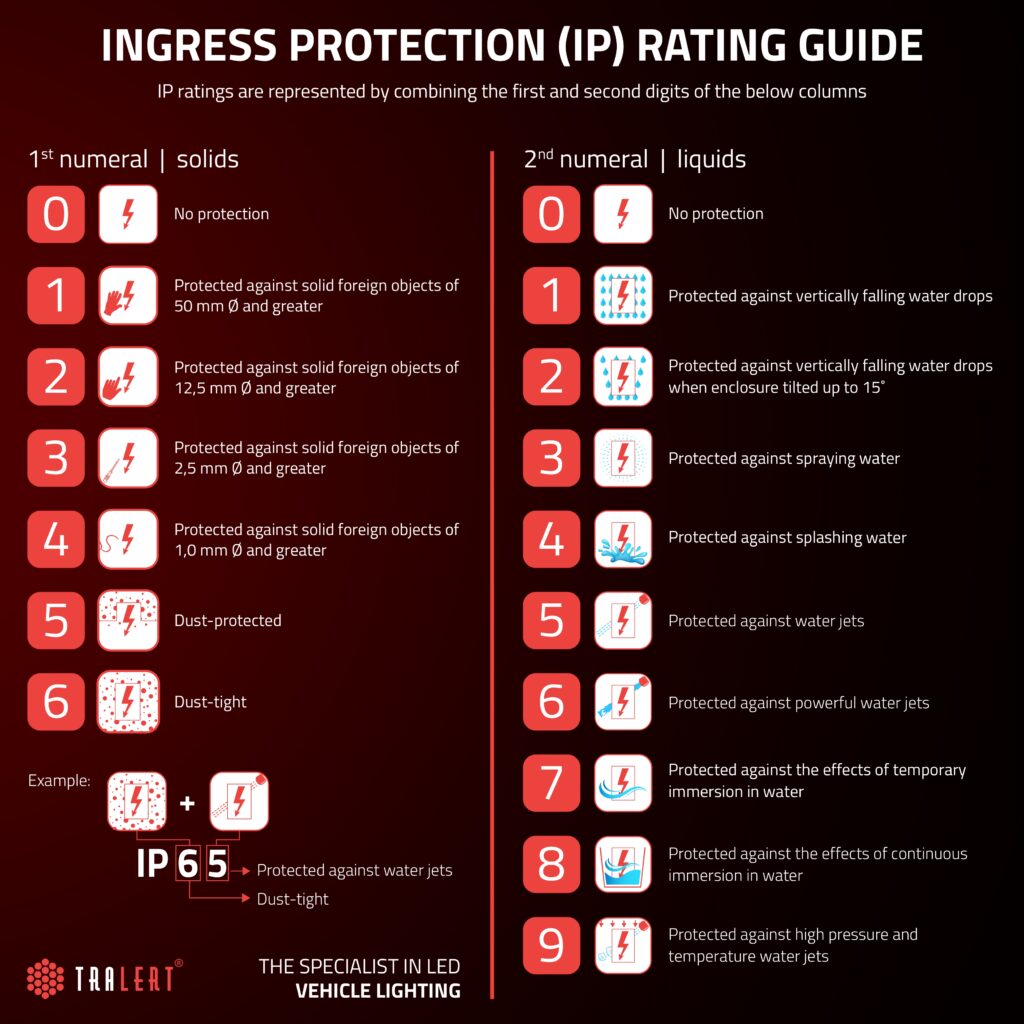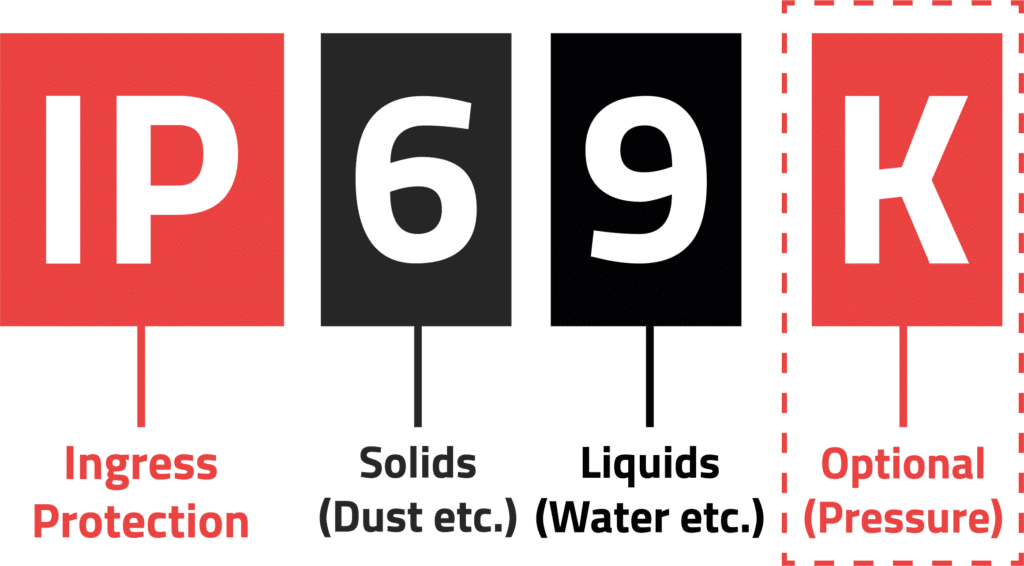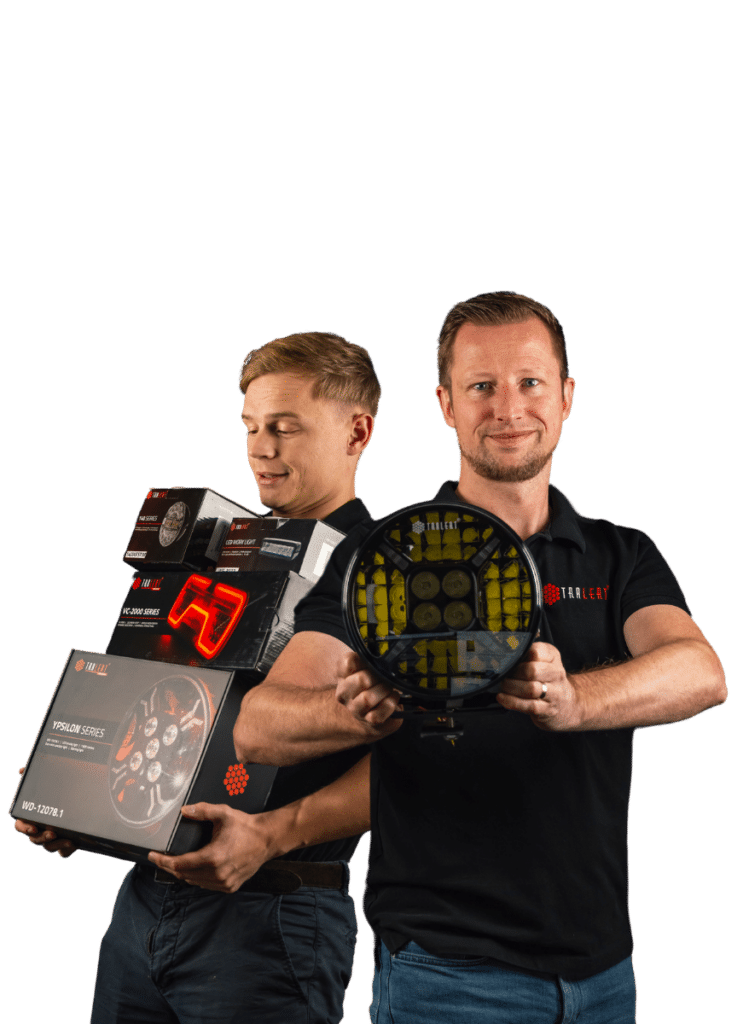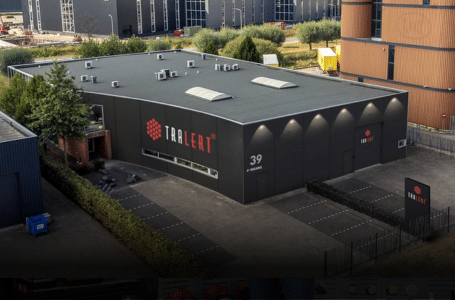Ingress Protection values, or IP ratings, are standardized classifications that indicate how well electronic and mechanical devices are protected against the ingress of solid particles such as dust and liquids such as water.
What if you could easily assess and compare this robustness? These ratings serve as your key to understanding the durability and resistance of a device or component in various environments. This way, you are always well-informed about what to expect when it comes to exposure to the elements.

How are IP values structured?
IP values consist of two digits, usually followed by the letter "K" (although this is optional). The two digits in the classification each have a specific meaning.

IP-classification – First digit
(Protection against solid particles) The first digit in the IP classification indicates the extent to which a device is protected against solid particles such as dust and dirt. It can range from 0 (no protection) to 6 (complete protection against dust).
0 No protection against solid particles.
1 Protected against large solid particles (>50 mm).
2 Protected against medium-sized solid particles (>12.5 mm).
3 Protected against small solid particles (>2.5 mm).
4 Protected against very small solid particles (>1 mm).
5 Dust-tight (limited amount of dust allowed).
6 Completely dust-tight (no dust allowed).
IP-classification – Second digit.
(Protection against moisture) The second digit in the IP rating indicates the extent to which a device is protected against moisture and water. It can range from 0 (no protection) to 9K (resistant to high-pressure steam cleaning at high temperatures).
0 No protection against moisture.
1 Protected against dripping water.
2 Protected against dripping water when tilted at an angle (up to 15 degrees).
3 Protected against splashing water (rain-resistant).
4 Protected against splashing water from all directions.
5 Protected against low-pressure water jets.
6 Protected against powerful water jets.
7 Protected against immersion in water up to 1 meter deep.
8 Protected against continuous immersion in water (specific depth determined by specifications).
9K Resistant to high-pressure steam cleaning at high temperatures.
Optional letter "K."
The letter "K" is added at the end of the IP rating to indicate that the device is resistant to high-pressure steam cleaning at high temperatures (for example, IP69K).
| No protection. | Against >50mm objects. | Against fingers or similar objects. | Against tools. | Against wires. | Dust-resistant. | Dust-tight. | |
| No protection. | IP00 | IP10 | IP20 | IP30 | IP40 | IP50 | IP60 |
| Drops (vertical). | IP01 | IP11 | IP21 | IP31 | IP41 | IP51 | IP61 |
| Drops (max. 15° tilted). | IP02 | IP12 | IP22 | IP32 | IP42 | IP52 | IP62 |
| Spray water (max. 60°). | IP03 | IP13 | IP23 | IP33 | IP43 | IP53 | IP63 |
| Splash water (all directions). | IP04 | IP14 | IP24 | IP34 | IP44 | IP54 | IP64 |
| Water jets (all directions). | IP05 | IP15 | IP25 | IP35 | IP45 | IP55 | IP65 |
| Powerful water jets (all directions). | IP06 | IP16 | IP26 | IP36 | IP46 | IP56 | IP66 |
| Temporary immersion. | IP07 | IP17 | IP27 | IP37 | IP47 | IP57 | IP67 |
| Prolonged immersion. | IP08 | IP18 | IP28 | IP38 | IP48 | IP58 | IP68 |
| High-pressure cleaning with hot water and steam. | IP09 | IP19 | IP29 | IP39 | IP49 | IP59 | IP69K |
Why are IP ratings important?
IP ratings are crucial to ensure that electronic and mechanical devices and components continue to function properly in their intended environments. Understanding the IP classification allows designers, manufacturers, and users to assess the suitability of a device for specific conditions, such as vehicles, agricultural machinery, food processing equipment, and more.
In the world of technology and engineering, IP ratings are a universal language to understand the degree of protection against dust and humidity, which is crucial for ensuring the durability and reliability of devices in various applications.
IP65 Meaning
Protection against dust and low-pressure water jets.
The IP65 rating is a standardized designation used to indicate the level of protection that electronic and mechanical devices provide against the ingress of solid particles (such as dust) and low-pressure water jets. IP65 is designed to offer protection against dust and water that can be sprayed onto the device with low pressure.
What you need to know about the IP65 classification.
The first digit in the IP rating (the "6" in IP65) indicates that the device is completely dust-tight. This means it does not allow dust particles or other solid particles to penetrate the internal operation of the device, which can be essential in environments where dust and dirt are present.
The second digit in the IP rating (the "5" in IP65) indicates that the device is protected against low-pressure water jets from all directions. This means the device is resistant to low-pressure water jets but not to immersion in water or powerful water jets.
Applications of IP65
IP65 devices are suitable for applications where protection against dust and protection against low-pressure water jets are important. This can range from outdoor electronic enclosures to control panels in factory environments where regular cleaning with water is necessary.
It is important to consider the specific needs of an application and the expected environmental conditions when choosing the appropriate IP rating. IP65 provides specific protection that can be useful in situations where protection against dust and low-pressure water jets is required but where no powerful water ingress or immersion is expected.
IP66 Significance:
Protection against dust and powerful water jets.
IP66 rating is a standardized designation indicating the level of protection that electronic and mechanical devices offer against the ingress of solid particles (such as dust) and powerful water jets. IP66 is designed to provide protection against dust and water that can be sprayed onto the device with powerful water jets.
What you need to know about the IP66 classification.
The first digit in the IP rating (the "6" in IP66) indicates that the device is completely dust-tight. This means it does not allow dust particles or other solid particles to penetrate the internal operation of the device, which can be essential in environments where dust and dirt are present.
The second digit in the IP rating (the "6" in IP66) indicates that the device is protected against powerful water jets from all directions. This means the device is resistant to powerful water jets but not to immersion in water.
Applications of IP66
IP66 devices are suitable for applications where protection against dust and protection against powerful water jets are important. This can range from outdoor lighting to electrical control panels in industrial environments where regular cleaning with high-pressure water is required.
It is essential to consider the specific needs of an application and the expected environmental conditions when choosing the appropriate IP rating. IP66 provides specific protection that can be useful in situations where protection against dust and powerful water jets is required, but where immersion in water is not expected.
IP67 meaning (limited waterproofing)
Protection against dust and temporary immersion in water.
The IP67 classification is a standardized designation used to indicate the level of protection that electronic and mechanical devices provide against the ingress of solid particles (such as dust) and temporary immersion in water. IP67 is designed to offer protection against dust and temporary immersion in water, but not against prolonged immersion or high water pressure.
What you need to know about the IP67 classification.
The first digit in the IP rating (the "6" in IP67) indicates that the device is completely dust-tight. This means it does not allow dust particles or other solid particles to penetrate the internal operation of the device, which can be essential in dusty environments.
The second digit in the IP rating (the "7" in IP67) indicates that the device is protected against temporary immersion in water up to a depth of 1 meter for a maximum of 30 minutes. This means the device can be submerged in water for short periods without affecting its operation.
Applications of IP67
IP67 devices are suitable for applications where protection against dust and temporary immersion in water is important. This can range from outdoor sports equipment to industrial sensors located in environments where the risk of temporary exposure to water exists.
It is important to consider the specific needs of an application and the expected environmental conditions when choosing the appropriate IP rating. IP67 provides specific protection that can be useful in situations where temporary immersion in water and protection against dust are required, but where prolonged immersion or high water pressure is not expected.
IP68 meaning (long-term waterproof)

Protection against dust and continuous immersion in water.
Solution: Use a multimeter to check if voltage is present at the correct points. Inspect the wiring for damage and replace defective connectors. If the issue lies within the system, a CAN-bus control box can help transmit the correct signals and prevent malfunctions.
What you need to know about the IP68 classification.
The first digit in the IP rating (the "6" in IP68) indicates that the device is completely dust-tight. This means it does not allow dust particles or other solid particles to penetrate the internal operation of the device, which can be crucial in dusty environments.
The second digit in the IP rating (the "8" in IP68) indicates that the device is protected against continuous immersion in water under specific conditions. While the exact specifications may vary, IP68 generally means that the device can be submerged in water up to a certain depth, often several meters, for an extended period without damage.
Applications of IP68
IP68 devices are suitable for applications where protection against dust and continuous immersion in water is required. This can range from underwater cameras and diving equipment to industrial sensors used in wet environments.
It is important to remember that while IP68 provides protection against immersion, the exact specifications may vary between different manufacturers and models. Therefore, it is crucial to check the specifications of a specific device to understand how deep and how long it can safely be submerged in water.
IP69K significance (highest protection)
Highest protection against dust, high-pressure steam cleaning, and high temperatures.
De IP69K-classificatie is een extreem hoge mate van bescherming in de IP (Ingress Protection) -standaard. Het geeft aan dat een elektronisch of mechanisch apparaat volledig stofdicht is, bestand is tegen hogedrukreiniging met stoom bij zeer hoge temperaturen en ook bestand is tegen hoge druk van waterstralen met hoge temperatuur. IP69K-apparaten zijn ontworpen om te presteren in de meest veeleisende en hygiënische omgevingen, zoals die in de voedselverwerkingsindustrie.
What you need to know about the IP69K rating.
The first digit in the IP rating (the "6" in IP69K) indicates that the device is completely dust-tight. This means it does not allow dust particles or other solid particles to penetrate the internal operation of the device.
The second digit in the IP rating (the "9" in IP69K) indicates that the device is resistant to high-pressure steam cleaning at very high temperatures. IP69K devices can be cleaned with powerful water jets at temperatures up to 80°C, which can be crucial for maintaining hygiene standards in food processing environments.
The addition of "K" to the IP69 rating means that the device is also resistant to high-pressure water jets. This implies that the device can be exposed to powerful high-pressure water jets without damage, as used in cleaning applications in industrial environments.
Applications of IP69K
IP69K devices are ideal for applications where maximum protection against dust, high-pressure steam cleaning, and high-pressure water jets is required. Examples include machinery in the food processing industry, medical equipment, and industrial devices that need to be cleaned with powerful cleaning processes.
The IP69K rating is the most robust and rigorous protection standard and is often used in environments where hygiene and cleanability are of utmost importance to ensure safety and quality.
The differences between the various IP ratings
IP60, IP61, IP62, IP63, IP64
These IP ratings provide protection against dust and vertical water droplets from above, but they have different levels of water protection and angles of droplets (for example, IP62 may tolerate some tilting).
IP65 vs IP66 vs IP67
IP65 provides protection against dust and low-pressure water jets from all directions.
IP66 provides protection against dust and powerful water jets from all directions.
IP67 Provides protection against dust and temporary immersion in water to a certain depth for up to 30 minutes.
IP68 vs IP69
IP68 provides protection against dust and continuous immersion in water under specific conditions.
IP69 Offers the highest possible protection against dust, high-pressure steam cleaning, high-pressure water jets, and high temperatures.
The main differences between these IP ratings lie in their levels of protection against dust, waterproofing, tolerance for water jets, and, in some cases, the ability to withstand steam cleaning and high-pressure water jets. The choice of the right IP rating depends on the specific needs of the application and the environmental conditions in which the device will be used. It is important to select the IP rating that best aligns with the application requirements to ensure performance and durability.
Summary
IP values are standardized classifications indicating the level of protection devices offer against dust and moisture. These range from basic protection (IP60) to high resistance against immersion and heat (IP69K). Careful selection of the appropriate IP rating is essential to ensure the performance and durability of a device in specific environments.
External sources: International Electrotechnical Commission

